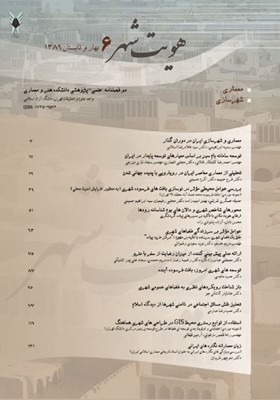زبان معمارانه نگارههای ایرانی
محورهای موضوعی : معماری
1 - عضو هیات علمی دانشگاه آزاد اسلامی واحد دکترای معماری و عضو هیأت علمی گروه معماری، دانشگاه آزاد اسلامی، واحد همدان
کلید واژه: Miniature, نگارگری ایرانی, Persian Painting, تاریخ معماری اسلامی ایران, اسناد تصویری تاریخ معماری, بازنمایی معماری, history of Iranian Islamic architecture, visual historical documents of architecture, representation of architecture,
چکیده مقاله :
اسناد تاریخ معماری اسلامی ایران به ویژه اسناد تصویری کمتر مورد توجه قرار گرفتهاند. نقشههای ترسیمی بناها از این دوران اندکاند، در عوض نگارههای بسیاری از دوران اسلامی بهویژه از ایلخانی تا اوایل صفوی باقی مانده است که میتواند به عنوان اسناد معماری مورد بررسی قرار گیرد. سؤالات پژوهش این بود که نگارهها چگونه همچون اسناد تاریخی میتوانند برای شناخت معماری اسلامی ایران مورد استفاده قرار گیرند و با بهکاربستن چه روشهایی، چه نوع دادههای تاریخی را میتوان دریافت و اعتبار آنها را چگونه باید ارزیابی نمود. برای پاسخ دادن به این پرسشها به بررسی شیوههای بیانی نگارگری در تبیین معماری، بررسی تاریخ تصویر بناهای معماری، مقایسه نگارهها با نمونههای معماری اسلامی ایران و نگارههای دیگر فرهنگهای اسلامی پرداخته شده است. در نهایت ویژگیهای بیانی نگارگری اسلامی ایران در تبیین معماری ایرانی ارائه شده است. به علاوه معانی اجتماعی معماری با روش معناشناسی تطبقی و بازخوانی بناهای معماری آمده است.
The documents of Iranian Islamic architecture especially visual documents are few and diffuse. However these documents were attended little. Considerable paintings of the Islamic era, especially Ilkhanid, Timurid and early Safavid period have remained that can be evaluated and searched. This study, wants to show how Persian paintings (Miniature) as historical documents can be used for cognition Iranian Islamic architecture. What ways can be used for analysis them? What kinds of historical data can be apprehended and how validity them to be assessed? For answering these questions, "language" of Persian paintings must were understood. The research based on historical method. For understanding language of Persian painting applied three strategies: History of architectural representation was evaluated and tow ways of representation of architecture in painting were obtained. Expressive features of Persian paintings were reviewed. Therefore, Persian paintings that represented well-known buildings were compared whit the building. For example three paintings from Nezami's quintuplet poem (khamse) were selected and compared by Taq-e-Bostan and also three Persian painting that were represented Mecca. Persian paintings were compared whit samples of extant Iranian and other Islamic architecture. For example, representation of house in a Persian painting was evaluated. In each of parts a case was evaluated. Cases review process include: dating represented architecture and dating Persian painting; evaluating validity of the painting as historical document; attention to features manuscript; evaluating purports of text and determining the general topics and themes; measure the degree of match with the reality of architecture by evidence; comparing the Persian painting and contemporaneous extant architecture or other Persian paintings same version or school; detecting architectural elements and details in painting, rereading represented architecture and interpreting it. Finally, expressive features Persian paintings in representation of Iranian architecture are presented. Briefly Persian paintings features in the expression of Islamic architecture include: the use of multiple simultaneous isometric perspective; illustrating simultaneously inside and outside the space; imaging asynchronous events in an image; refer the three-dimensional two-dimensional; representing walls up to ceiling indoor; equal importance floor and wall display; components with respect to total of real space; independence scale of building and the human's scale; remove walls to see them back; reduce distances and compact show to space; choose the smallest component of architectural space for illustrating while maintaining a whole room due to limited spaces in the painting; display main elements and display some minor elements; use a virtual frame as metonymy of the inside and outside architecture. In addition, review showed that the difference representation (painting) and reality (building) in known buildings was significant. Referring to other texts (paintings and architecture) and compare those (intertextuality) by methods of historical semantics and symbolic show social meaning of the represented architecture. Using Persian paintings and relying on evidence in other fields can be readout architecture, to pay (for example a house of Ilkhanid period was readout). Persian paintings can be as "cognitive maps" to examine and review aspects of environmental psychology concepts such as "personal space", "proximity ", and "territorial behavior".
_||_


